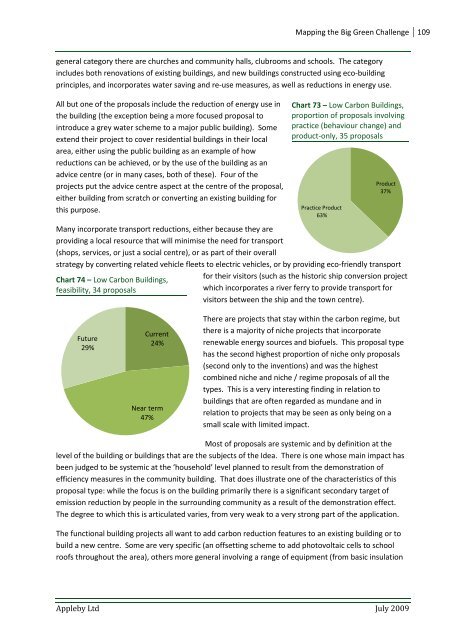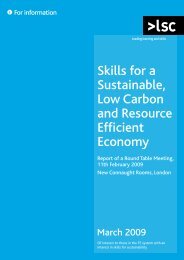Mapping the Big Green Challenge - The Skills & Learning ...
Mapping the Big Green Challenge - The Skills & Learning ...
Mapping the Big Green Challenge - The Skills & Learning ...
Create successful ePaper yourself
Turn your PDF publications into a flip-book with our unique Google optimized e-Paper software.
<strong>Mapping</strong> <strong>the</strong> <strong>Big</strong> <strong>Green</strong> <strong>Challenge</strong> 109general category <strong>the</strong>re are churches and community halls, clubrooms and schools. <strong>The</strong> categoryincludes both renovations of existing buildings, and new buildings constructed using eco-buildingprinciples, and incorporates water saving and re-use measures, as well as reductions in energy use.All but one of <strong>the</strong> proposals include <strong>the</strong> reduction of energy use in<strong>the</strong> building (<strong>the</strong> exception being a more focused proposal tointroduce a grey water scheme to a major public building). Someextend <strong>the</strong>ir project to cover residential buildings in <strong>the</strong>ir localarea, ei<strong>the</strong>r using <strong>the</strong> public building as an example of howreductions can be achieved, or by <strong>the</strong> use of <strong>the</strong> building as anadvice centre (or in many cases, both of <strong>the</strong>se). Four of <strong>the</strong>projects put <strong>the</strong> advice centre aspect at <strong>the</strong> centre of <strong>the</strong> proposal,ei<strong>the</strong>r building from scratch or converting an existing building forthis purpose.Many incorporate transport reductions, ei<strong>the</strong>r because <strong>the</strong>y areproviding a local resource that will minimise <strong>the</strong> need for transport(shops, services, or just a social centre), or as part of <strong>the</strong>ir overallstrategy by converting related vehicle fleets to electric vehicles, or by providing eco-friendly transportChart 74 – Low Carbon Buildings,feasibility, 34 proposalsChart 73 – Low Carbon Buildings,proportion of proposals involvingpractice (behaviour change) andproduct-only, 35 proposalsPractice Product63%Product37%for <strong>the</strong>ir visitors (such as <strong>the</strong> historic ship conversion projectwhich incorporates a river ferry to provide transport forvisitors between <strong>the</strong> ship and <strong>the</strong> town centre).Future29%Current24%Near term47%<strong>The</strong>re are projects that stay within <strong>the</strong> carbon regime, but<strong>the</strong>re is a majority of niche projects that incorporaterenewable energy sources and biofuels. This proposal typehas <strong>the</strong> second highest proportion of niche only proposals(second only to <strong>the</strong> inventions) and was <strong>the</strong> highestcombined niche and niche / regime proposals of all <strong>the</strong>types. This is a very interesting finding in relation tobuildings that are often regarded as mundane and inrelation to projects that may be seen as only being on asmall scale with limited impact.Most of proposals are systemic and by definition at <strong>the</strong>level of <strong>the</strong> building or buildings that are <strong>the</strong> subjects of <strong>the</strong> Idea. <strong>The</strong>re is one whose main impact hasbeen judged to be systemic at <strong>the</strong> ‘household’ level planned to result from <strong>the</strong> demonstration ofefficiency measures in <strong>the</strong> community building. That does illustrate one of <strong>the</strong> characteristics of thisproposal type: while <strong>the</strong> focus is on <strong>the</strong> building primarily <strong>the</strong>re is a significant secondary target ofemission reduction by people in <strong>the</strong> surrounding community as a result of <strong>the</strong> demonstration effect.<strong>The</strong> degree to which this is articulated varies, from very weak to a very strong part of <strong>the</strong> application.<strong>The</strong> functional building projects all want to add carbon reduction features to an existing building or tobuild a new centre. Some are very specific (an offsetting scheme to add photovoltaic cells to schoolroofs throughout <strong>the</strong> area), o<strong>the</strong>rs more general involving a range of equipment (from basic insulationAppleby Ltd July 2009











